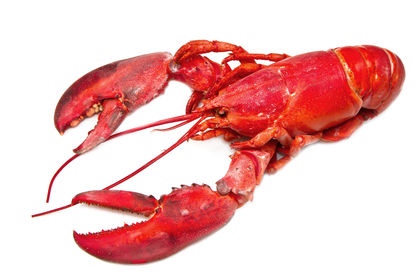Stamp: Freshwater Shrimp (Macrobrachium sp.) (Saint Vincent and The Grenadines 1999)
Freshwater Shrimp (Macrobrachium sp.) (Saint Vincent and The Grenadines 1999)
01 January (Saint Vincent and The Grenadines ) within release Revenue goes into circulation Stamp Freshwater Shrimp (Macrobrachium sp.) face value 10 East Caribbean cent
Stamp is square format.
$1.50 postage stamp of 1986 (SG 1048) overprinted "REVENUE" and surcharged "10¢" and obliterating block in black Revenue Reverend cat. no: R234Also in the issue Revenue:
- Stamp - “Mary and de Baby weary” face value 10;
- Stamp - “Star above shine in de sky” face value 10;
- Stamp - American man of war face value 10;
- Stamp - Astronomer and telescope face value 10;
- Stamp - Ayres Turbo Thrush face value 10;
- Stamp - Boy and officer face value 10;
- Stamp - British man of war face value 10;
- Stamp - British troops in battle face value 10;
- Stamp - Carib hieroglyph face value 10;
- Stamp - Christmas 1981 face value 10;
- Stamp - Christmas 1981 face value 10;
- Stamp - Christmas 1982 face value 10;
- Stamp - Christmas 1983 face value 10;
- Stamp - Christmas 1984 face value 10;
- Stamp - Christmas 1984 face value 10;
- Stamp - Coconut plantation, husking coconuts face value 10;
- Stamp - Common Black Hawk (Buteogallus anthracinus) face value 10;
- Stamp - Copra drying frames face value 10;
- Stamp - Crayfishing face value 10;
- Stamp - Elegant Anemone (Actinoporus elegans) face value 10;
- Stamp - Emblem face value 10;
- Stamp - Emblem face value 10;
- Stamp - Flag of St Vincent and Commonwealth symbol face value 10;
- Stamp - Flour Milling face value 10;
- Stamp - Freshwater Shrimp (Macrobrachium sp.) face value 10;
- Stamp - Goat-skin drum face value 10;
- Stamp - Grumman Goose, 1952 face value 10;
- Stamp - Guava face value 10;
- Stamp - Hoeing face value 10;
- Stamp - Humming Bird (Eulampis jugularis) face value 10;
- Stamp - Junior Secondary School face value 10;
- Stamp - Kim de Freitas face value 10;
- Stamp - Kingstown General Post Office face value 10;
- Stamp - Kingstown General Post Office face value 10;
- Stamp - Lady of the Night (Cestrum nocturnum) face value 10;
- Stamp - Locust (Hymenaea coubaril) face value 10;
- Stamp - Model sailing dinghy face value 10;
- Stamp - Musical fantasy face value 10;
- Stamp - Passion Fruit face value 10;
- Stamp - Prickly Pear cactus face value 10;
- Stamp - Prime Minister R. Milton Cato face value 10;
- Stamp - Prime Minister R. Milton Cato face value 10;
- Stamp - Ramillies lost in storm face value 10;
- Stamp - Soufrière Bird (Myadestes genibarbis sibilans) face value 10;
- Stamp - View of Fort Duvernette face value 10;
- Stamp - Westminster Abbey face value 10;
- Stamp - Women's basketball face value 10;
- Stamp - Yachts racing face value 10;
- Stamp - Painting "Poinsettia" by Jackie Douglas face value 10;
Stamp Freshwater Shrimp (Macrobrachium sp.) it reflects the thematic directions:
Animals are multicellular, eukaryotic organisms of the kingdom Animalia (also called Metazoa). All animals are motile, meaning they can move spontaneously and independently, at some point in their lives. Their body plan eventually becomes fixed as they develop, although some undergo a process of metamorphosis later on in their lives. All animals are heterotrophs: they must ingest other organisms or their products for sustenance.
Crustaceans are a group of arthropods that are a part of the subphylum Crustacea (/krəˈsteɪʃə/), a large, diverse group of mainly aquatic arthropods including decapods (shrimps, prawns, crabs, lobsters and crayfish), seed shrimp, branchiopods, fish lice, krill, remipedes, isopods, barnacles, copepods, opossum shrimps, amphipods and mantis shrimp. The crustacean group can be treated as a subphylum under the clade Mandibulata. It is now well accepted that the hexapods (insects and entognathans) emerged deep in the Crustacean group, with the completed group referred to as Pancrustacea. The three classes Cephalocarida, Branchiopoda and Remipedia are more closely related to the hexapods than they are to any of the other crustaceans (oligostracans and multicrustaceans)
Marine life, or sea life or ocean life, refers to the plants, animals and other organisms that live in the salt water of the sea or ocean, or the brackish water of coastal estuaries. At a fundamental level, marine life helps determine the very nature of our planet. Marine organisms produce much of the oxygen we breathe. Shorelines are in part shaped and protected by marine life, and some marine organisms even help create new land. Altogether there are 230,000 documented marine species, including over 16,000 species of fish, and it has been estimated that nearly two million marine species are yet to be documented. Marine species range in size from the microscopic, including plankton and phytoplankton which can be as small as 0.02 micrometres, to huge cetaceans (whales, dolphins and porpoises) which in the case of the blue whale reach up to 33 metres (109 feet) in length, being the largest known animal.



